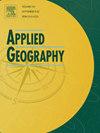Domesticating sustainability transitions: Spatial and temporal variation of industrial eco-efficiency in China
IF 4
2区 地球科学
Q1 GEOGRAPHY
引用次数: 0
Abstract
This study analyses regional industrial sustainability transitions from global and local perspectives. We measure industrial eco-efficiency (IEE) of 280 cities in China from 2010 to 2020 and analyze potential influencing factors using geographical and temporal weighted regression model. We find that foreign investment and international trade are positively associated with IEE with diminishing effects, and then local household consumption enhances IEE on the basis of local environmental governance. The effects of international environmental regulations and technology spillover on IEE are positive, as they align with China's drive for innovation. We further categorize cities into five distinct types based on the influences of both global and local factors—dominated by local environmental regulations, driven by international standards, propelled by foreign investment, shaped by local market dynamics, and affected by multiple factors. We conclude that regional industrial sustainability transitions in China are influenced by forces operating at various scales and exhibit distinct spatiotemporal variation. The drivers of these transitions have shifted from a global scale to a local scale, and both regional conditions and the stage of industrialization significantly affect the intensity of actions undertaken by different scale factors. Finally, we propose policy recommendations, considering regional heterogeneity and the stages of industrialization.
可持续性转型的本土化:中国工业生态效率的时空变化
本研究从全球和地方视角分析了区域工业可持续性转型。我们测算了中国 280 个城市从 2010 年到 2020 年的工业生态效率(IEE),并利用地理和时间加权回归模型分析了潜在的影响因素。我们发现,外商投资和国际贸易与工业生态效率正相关,但影响递减,而本地家庭消费则在本地环境治理的基础上提高了工业生态效率。国际环境法规和技术外溢对 IEE 的影响是正向的,因为它们与中国的创新驱动力相一致。根据全球和地方因素的影响,我们进一步将城市分为五种不同类型--地方环境法规主导型、国际标准驱动型、外商投资推动型、地方市场动态塑造型和多重因素影响型。我们的结论是,中国的区域工业可持续发展转型受到不同规模力量的影响,并表现出明显的时空差异。这些转型的驱动因素已从全球尺度转向地方尺度,而地区条件和工业化阶段会显著影响不同尺度因素的作用强度。最后,考虑到地区差异和工业化阶段,我们提出了政策建议。
本文章由计算机程序翻译,如有差异,请以英文原文为准。
求助全文
约1分钟内获得全文
求助全文
来源期刊

Applied Geography
GEOGRAPHY-
CiteScore
8.00
自引率
2.00%
发文量
134
期刊介绍:
Applied Geography is a journal devoted to the publication of research which utilizes geographic approaches (human, physical, nature-society and GIScience) to resolve human problems that have a spatial dimension. These problems may be related to the assessment, management and allocation of the world physical and/or human resources. The underlying rationale of the journal is that only through a clear understanding of the relevant societal, physical, and coupled natural-humans systems can we resolve such problems. Papers are invited on any theme involving the application of geographical theory and methodology in the resolution of human problems.
 求助内容:
求助内容: 应助结果提醒方式:
应助结果提醒方式:


